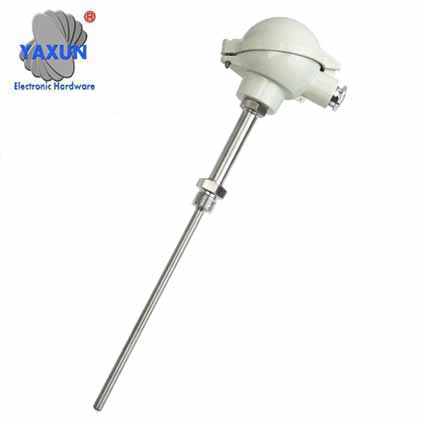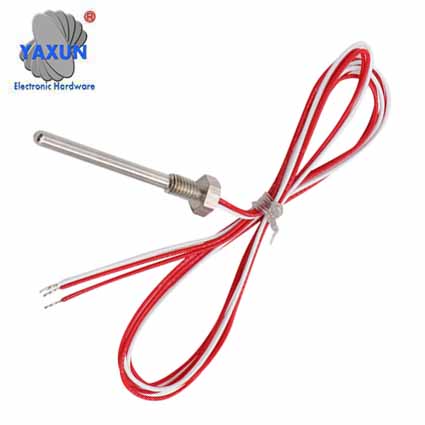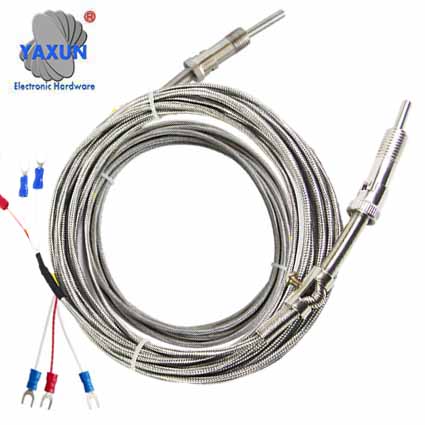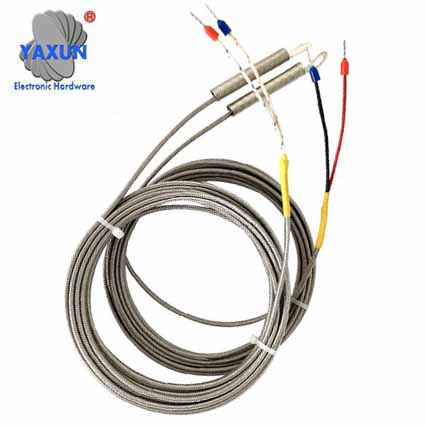China Manufacturer of Thermal Resistance Temperature Sensor

What platinum thermal resistance sensor and function? Production and selection of PT100 and PT1000 thermal resistance sensor
Resistance thermometer sensors are electrical components that use the temperature dependency of the electrical resistance of an electrical conductor to measure the temperature.Pure metals are preferably suitable as resistance material. They show greater changes in resistance than alloys. They also have an almost linear relationship between resistance and temperature. Corrosion-resistant platinum is preferably used for reliable measurements, since it shows particularly little aging and since it can be used to manufacture thermometers with low error limits.
Platinum resistance thermometers sensor for industrial use consist of a measuring insert in a fitting that protects against corrosion. The wiring of the measuring insert is often done in a connection head, from where the thermometer can be connected to an external electrical measuring device via a cable. The measuring insert is an easily exchangeable unit, usually with a ceramic or stainless steel jacket and a connection base; this insert contains one or more platinum measuring resistors at its end. In addition to the clamping screws for the wiring, the measuring insert shown in the picture also contains two spring-loaded mounting screws in the connection base, which provide the necessary pressure for good thermal contact with the protective tube.
Conventional thermometers sensor measure the temperature based on the change in length or volume of a substance and are only suitable as indicating measuring devices. The advantage of resistance thermometers sensor is that they deliver an electrical signal and are suitable for use in industrial measurement technology.

platinum
For the platinum resistance thermometers sensor widely used in industrial measurement technology and the measuring resistors used in them, there is a standard in which additional summands are specified for the function behind the linear term.The nominal value is specified, i.e. the resistance at 0 ° C.Resistors with a nominal value of 100 Ω are preferably used; these sensors are called Pt100. Other common nominal values are 500 Ω and 1000 Ω. Details are given under the heading platinum measuring resistor. The values in the table below are calculated using these equations.
The definition range says nothing about the temperature up to which a measuring resistor or measuring insert can actually be used; the permissible range of application depends on the total materials used and is specified by the manufacturer in the catalog. Platinum resistance thermometers sensor can be used for significantly smaller ranges or, with the appropriate design, extrapolated the characteristic curve down to −250 ° C or +1000 ° C.
A platinum thermometer sensor should be assigned an accuracy class by the manufacturer. In the specified standard, the maximum permissible measurement deviations (limit deviations) are specified for each class:
| class | Scope | Limit deviation | |
|---|---|---|---|
| Wire wound resistors | Sheet resistors | ||
| AA | −50 … +250 °C | 0 … +150 °C | 0,1 °C + 0,0017 ∙ |t| |
| A | −100 … +450 °C | −30 … +300 °C | 0,15 °C + 0,002 ∙ |t| |
| B | −196 … +600 °C | −50 … +500 °C | 0,3 °C + 0,005 ∙ |t| |
| C | −196 … +600 °C | −50 … +600 °C | 0,6 °C + 0,01 ∙ |t| |

Example for the preferably used class B: At 500 ° C, deviations of the measured value are permissible up to ± 2.8 ° C.
The temperature coefficient of the resistance is specified in the standard somewhat differently than often (and also above) than
i.e. at the reference temperature of 0 ° C instead of 20 ° C. The mean temperature coefficient over the range 0 ... 100 ° C results from and is used as a characterizing value.
if the deviations are in the range of −20… +120 ° C, the amount is less than 0.4 ° C. They are not greater than the limit deviations specified above (error limits due to production fluctuations) in class B.
Normally, measurements are taken and the temperature t is sought. The resolution ("inversion") after t or the linearization (generation of an output signal that is linearly linked not with the resistance but with the temperature) is partly carried out by a transmitter integrated in the measuring insert, see below for measuring circuits.
nickel
Compared to platinum, nickel is more sensitive; it provides a greater change in relative resistance for the same change in temperature. However, this material has been removed from the standardization. The following equation applies to the temperature response in the range from −60 ° C to +250 ° C:with t the temperature in ° C; .
In addition to the Ni100 with R_0 = 100 Ω, the versions Ni500 with 500 Ω and Ni1000 with 1000 Ω were in use.
| Scope | Limit deviation |
| −60 … 0 °C | 0,4 °C + 0,028 ∙ |t| |
| 0 … 250 °C | 0,4 °C + 0,007 · |t| |
Disadvantages in comparison to the platinum measuring resistor are the smaller temperature range (−60… +250 ° C) and the larger limit deviation, especially in the range below 0 ° C.
silicon
Silicon measuring resistors can be used in the range of −50… +150 ° C. According to the data sheet, the following equation applies to their temperature response in the range of −30 ... +130 ° C:In the data sheet mentioned, nominal values are given for 1000 Ω and 2000 Ω with a measuring current of 1 mA with limit deviations of 1… 3%.
There are also integrated circuits with a linearized output signal for the same temperature range, for example with a nominal 1 μA / K or 10 mV / K with a supply voltage of 4 ... 30 V; for example .
Thermistor
NTC thermistors show a highly non-linear relationship between resistance and temperature. The following function is used as a useful approximation of the temperature-dependent resistance, which has the absolute temperature T as an argument:It decreases quadratically with increasing absolute temperature. In the usual permitted working range between −50 ° C and +125 ° C, this can change by a factor of around 3.
NTC thermistors show poor long-term constancy, change their resistance due to moisture, have a certain memory (resistance depends on the previous history), so that they are not very suitable for measurement purposes. They are used for non-critical temperature monitoring as well as for simple temperature measurements with accuracy requirements of 1… 3 K (example: microcontroller boards, battery temperatures / sensor temperatures in cameras). In these cases, linearization is usually carried out using stored lookup tables.
Depending on the version, NTC thermistors can be used in the range between approximately −55 ° C and a maximum of +250 ° C. They are made in the form of rods, discs or pearls, some of which are encased in glass.

Measuring circuits
Measuring circuits for resistance thermometer sensorTo measure the resistance, a constant current must flow through the resistance. The applied voltage is an easily measurable signal proportional to the resistance. Often, however, it is not this voltage that is measured, but only its change compared to an initial value by means of a differential circuit (Wheatstone bridge). In order to keep the error due to self-heating low, the measuring current must be as low as possible, typically not higher than one milliampere for Pt100.
In industrial systems, larger distances between the sensor and transmitter often have to be bridged with correspondingly long supply lines. In order to avoid the influence of the resistance of the lines on the measured value, platinum resistance sensors are also manufactured with three or four wire connections. This enables the measuring current to be fed in separately or the feed line error can be compensated. In outdoor areas, installation with three or four ladders is strongly recommended. Alternatively, a first transmitter is already housed in the connection head.
Sources of error
As with all contact thermometers, static and retarding heat conduction influences must be taken into account. In the case of resistance thermometers, the influence of the resistance of the measuring lines can also be considered as a source of error:Insufficient insulation resistance
An inadequate insulation resistance can be viewed electrically as a parasitic parallel resistance to the measuring resistor. It therefore means that the evaluating components show a temperature that is too low. It usually arises during the production of the sensors through the penetration of moisture into the measuring insert, especially where mineral-insulated sheathed cables with hygroscopic insulation material such as magnesium or aluminum oxide powder are used. For platinum measuring resistors according to, an insulation resistance of ≥100 MΩ with a direct voltage of at least 100 V at room temperature is prescribed, but only ≥0.5 MΩ at 500 ° C and 10 V.
Self-heating
The measuring current generates a power loss at the measuring resistor, which is converted into heat and depends on the basic value, the measuring temperature, the design and the heat conduction and capacity. Since a measurement current of 1 mA is generally not exceeded, this power loss with a Pt100 is in the range of a few tenths of a milliwatt and normally does not generate any significant measurement errors. Self-heating only has to be taken into account in rare cases and determined for the respective application under operating conditions.
Hysteresis
The hysteresis is noticeable in that the thermometer no longer measures the same value as before after large temperature changes. It is due to mechanical stresses in the sensor element, which arise from different expansion coefficients of the platinum and the carrier material or, in the case of glass sensors, of the casing. For platinum measuring resistors, this deviation caused by the pretreatment must not be greater than the limit deviation at the test temperature for the respective accuracy class in accordance with a test procedure specified in the associated standard.
Vorteile und Einschränkungen
Die Vorteile von Platin-Widerstandsthermometern sind:Hohe Genauigkeit
Geringe Drift
Großer Betriebsbereich
Eignung für Präzisions anwendungen.
Einschränkungen:
RTDs in industriellen Anwendungen werden selten über 660 °C eingesetzt. Bei Temperaturen über 660 °C wird es immer schwieriger, eine Verunreinigung des Platins durch Verunreinigungen aus dem Metallmantel des Thermometers zu verhindern. Aus diesem Grund ersetzen Labor Normal Thermometer den Metallmantel durch eine Glaskonstruktion. Bei sehr niedrigen Temperaturen, etwa unter −270 °C (3 K), wird der Widerstand eines RTD aufgrund der geringen Phononen hauptsächlich durch Verunreinigungen und Grenzstreuung bestimmt und ist damit grundsätzlich temperaturunabhängig. Als Ergebnis ist die Empfindlichkeit des RTD im Wesentlichen null und daher nicht nützlich.
Im Vergleich zu Thermistoren sind Platin-RTDs weniger empfindlich gegenüber kleinen Temperaturänderungen und haben eine langsamere Reaktionszeit. Thermistoren haben jedoch einen kleineren Temperaturbereich und eine kleinere Stabilität.
PREV:The manufacturer of the RTD PT100 sensor
NEXT:NONE
NEXT:NONE





